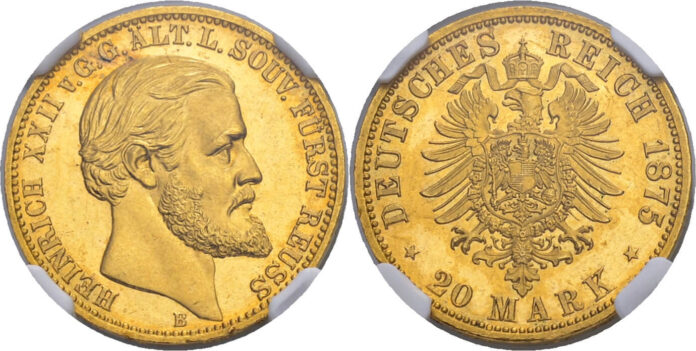First Auction of New Frankfurter Münzhandlung
As reported in the numismatic press, since the beginning of the year there has been a new auction house in Frankfurt, which, however, sees itself in the tradition of the predecessors it is named after and which is committed to their image and expertise. Thus, Frankfurter Münzhandlung Nachf. GmbH continues the old numbering with auction No. 153. The last auction, number 152, was held in 1999 by the then owner, the Swiss bank UBS.
On 8 November 2019, a small selection of ancient coins, German coins and medals, banknotes and orders will be offered at Fleming’s Hotel in Frankfurt am Main. In this way, the Frankfurter Münzhandlung – run by the experts of the well-known Swiss auction house SINCONA in Zurich – shows the full range of numismatics and the possibilities that can be offered to customers and collectors by the company’s site in Frankfurt at the heart of the European Union.
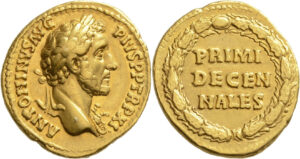
Ancient Coins
The first section offers a variety of Ancient Coins with interesting gold and silver pieces:
- 15: Sasanian Empire. Shapur I, 240-270. Dinar Ctesiphon. Göbl type I/1. Extremely rare. Very fine +. Estimate €5,000
- 28: Roman Empire. Aureus 114/117, Rome. Calicò 1026. RIC 319. About extremely fine. Estimate €5,000
- 29: Roman Empire. Antoninus Pius, 138-161. Aureus 147/148, Rome. Calicó 1613. Very rare. Extremely fine. Estimate €12,500

German Coins and Medals
In the second section, 150 German Coins and Medals are on offer including many extraordinarily preserved and/or very rare pieces:
- 53: Augsburg. Double taler 1625. Forster 164. Dav. 516. Gem. Extremely fine-FDC. Estimate €10,000
- 64: Brandenburg-Prussia. George William, 1619-1640. Taler 1638 LM, Cöln. Bahrfeldt 772 b. Dav. 6155. Very rare in this quality. Gem. Almost FDC. Estimate €8,500
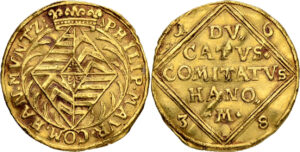
- 128: Hanau-Münzenberg. Philipp Moritz, 1612-1638. Ducat 1638. 3.37 g. Suchier -. Fr. -. Extremely rare. Probably the only known specimen. Slightly bent. Very fine +. Estimate €17,500
- 135: Jülich-Cleves-Berg. John William, 1679-1716. Ducat 1683, Düsseldorf. 3.30 g. Noss 747. Fr. 1395 a. Very rare. Bent. Very fine. Estimate €4,000
- 159: Palatinate. Frederick V, 1610-1623. Gold gulden 1621, Heidelberg. Fr. 1999. Very rare. Small edge chip at the rim. Extremely fine. Estimate €15,000
- 170: Saxony. Frederick III the Wise 1486-1525. Guldengroschen n.d. (after 1507). Commemorating becoming Governor General. With the title of Maximilian I. Die by Ulrich Ursenthaler the elder. Schnee 37. Dav. see 9699. Very rare, especially in this quality. Gem with fine lustre. Extremely fine-FDC. Estimate €17,500
- 175: Saxony. Frederick Augustus I, 1694-1733. Taler klippe 1717, Dresden. 29.14 g. Celebrating the new Schießhaus (hunter’s house) in Dresden. Without mint master’s mark. Kahnt 304. Dav. 2657. Very rare. Extremely fine. Estimate €2,500
- 203: Würzburg, diocese. Johann Philipp von Greiffenklau-Vollraths, 1699-1719. 4 ducats 1702, Würzburg. Helmschrott – (see 504, half taler). Fr. -. Unedited and extremely rare. Fields very slightly smoothed. Extremely fine. Estimate €30,000

German Empire
The auction’s core is an extensive collection of Gold Coins of the German Empire – 257 single lots, featuring almost exclusively objects of outstanding grade – followed by Silver Coins of the German Empire after 1871.
- 214: Anhalt. Frederick I, 1871-1904. 10 marks 1901 A. J. 180. Gem. NGC PF65 CAMEO. Estimate €3,000
- 263: Bavaria. Ludwig III, 1913-1918. 20 marks 1914 D. J. 202. NGC MS64. Estimate €5,000
- 317: Mecklenburg-Strelitz. Frederick William, 1860-1904. 20 marks 1873 A. J. 236. NGC MS64. Estimate €12,000
- 363: Prussia. Wilhelm II, 1888-1918. 10 marks 1889 A. J. 249. NGC PF67. Estimate €10,000
- 398: Reuss. Heinrich XXII, 1859-1902. 20 marks 1875 A. J. 254. NGC MS64+PL. Estimate €40,000
- 431. Saxe-Meiningen. Georg II, 1866-1914. 20 marks 1900 D. NGC MS63. Estimate €10,000
- 441: Schaumburg-Lippe. Adolf Georg, 1860-1893. 20 marks 1874 B. J. 284. NGC MS67. Estimate €10,000
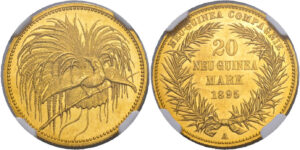
- 467: German New Guinea. 20 New Guinean marks 1895 A. Berlin. J. N709. NGC MS65+. Estimate €40,000
- 491: Saxe-Altenburg. Ernst, 1853-1908. 5 marks 1901 A. 75th birthday. J. 143. NGC PF65 CAMEO. Estimate €2,000
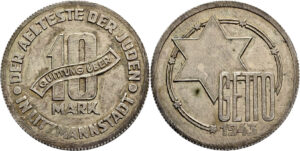
Ghetto Coins from Litzmannstadt and Trial Pieces
A special numismatic chapter is dedicated to the Ghetto Coins from Litzmannstadt. After the German administration had prohibited the circulation of the reichsmark in the ghetto in July 1940, banknotes in the form of so-called mark receipts (“Markquittungen”) were introduced as the ghetto’s currency. However, these banknotes were not successful and therefore replaced by coins, which were minted by the residents themselves. Thus, ghetto money was the only other means of payment that existed on German territory at that time, and therefore it belongs to the monetary history of Germany.
There has probably never been an auction offering the few known trial pieces and strikes of this specific money with other than magnesium or aluminium alloy. It is well known that these strikes had to be presented to the German control authorities – for example in the form of lead klippe coins – before the proper minting could begin. In addition to these trial pieces, off-metal strikes in silver, German silver and copper as well as coins with mint errors and multiple lots of 5 mark pieces, some of which containing more than 100 pieces, are on offer. All lots that contain ghetto coins are accompanied by an expert opinion confirming the coin’s authenticity.
- 553: 5 (pfennig) 1942. Two one-sided off-metal strikes in lead of the not approved drafts for this denomination that was never minted. Extremely rare, probably unique. Estimate €2,000
- 555: 20 marks receipt 1943. Off-metal strike in lead in the form of a klippe coin. Extremely rare. Estimate €1,800
- 556: 10 marks receipt 1943. 9.50 g. Off-metal strike in silver. Very rare, probably unique. Estimate €3,000

Banknotes
Another part of this auction of the Frankfurter Münzhandlung is dedicated to the History of Banknotes. The O. Seiffert collection of specimens has a very particular story: Seiffert, a privy councillor for financial affairs, was a member of the Reichsbank’s board of directors in Berlin and – among others – responsible for various issues during the hyperinflation of the Weimar Republic. His signature can be found on several specimens. At the end of 1924, Seiffert had the Reichsbank’s chief cashier’s office put together a collection for him, and – almost 100 years later – these banknotes, bearing the overprint MUSTER (“Specimen”), are still in the original envelopes of those days.
- 598: Germany, 50 trillion marks 1924, 10 February. Diagonal overprint MUSTER. Original envelope of the central bank. Very rare. Uncirculated. Estimate €1,250
- 605: Germany, 1000 reichsmarks 1924, 11 October. Specimen with underprinted letter A / serial number A.0000000. Diagonal overprint MUSTER. Original envelope of the central bank. Very rare. Uncirculated. Estimate €750
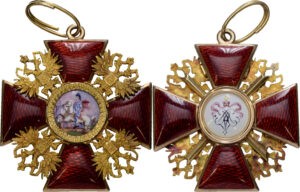
Phaleristics
In the auction’s last chapter, the company’s tradition in the field of phaleristics is also being continued. After the successful special auction with Orders and Decorations in the 1990s, we are pleased to be able to offer you 26 lots with exceptional provenances – described by the expert Michael Autengruber, Konstanz.
- 610: Kingdom of Württemberg: Civil merit order of the crown of Württemberg, grand cross breast star, embroidered. Awarded on 10 November 1817 to the Württemberg minister of justice Constantin Franz Fürchtegott von Neurath (1777-1817). Estimate €2,500
- 624: Russian Empire: Order of Alexander Nevsky, set of orders, jewel with sash ribbon and breast star, in a case. Awarded on 23 September 1864 to the Württemberg minister of justice Constantin Franz Freiherr von Neurath (1807-1876). Estimate €5,000
You can find the online auction catalogue on the website of the Frankfurter Münzhandlung, and additionally a PDF version.
In spring 2019, we reported on the re-opening of the Frankfurter Münzhandlung.
For further information on the auction house go directly to the website of the Frankfurter Münzhandlung.



